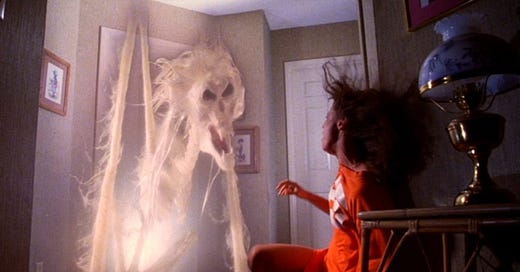All happy houses are alike; each haunted house is haunted in its own way.
–Leo Tolstoy (sort of)
Why do we as an audience keep returning to haunted houses? What draws us to this type of story?
Adam O’Fallon Price looks at classic examples of haunted house tales and sorts them into two categories: Stay Away Houses and Hungry Houses. Rose Czabo ties haunted house stories to the American dream of upward economic mobility, and that a haunted house exists to consume the strivers within. Looking at a specific text, Elaina Frulla points to Nathaniel Hawthorne’s The House of the Seven Gables as a novel to read for those interested in the origin of many haunted house tropes.
There are also personal connection an audience member can forge with these ghost stories. E.D. writes about how they first used haunted house stories to distract their mind from struggling with anorexia, but later came to find kinship with the characters from these stories. Films about haunting and possession gave them a language to describe the feelings of anorexia and body dysmorphia. B. Douglass Mckenna shares how haunted house stories helped them understand their own queerness, and how to embrace their true self.
But there’s also the leap in logic audiences need to make when engaging with a haunted house story. Why don’t they just leave? Can’t they sell the place? Why stay?
Charlotte, an accountant and notary, breaks down the costs and potential finances of the family from Insidious, suggesting the economic realities that would keep a family living with ghosts. Caitlin Busch interviews realtor James Harris about a time he had a house that seemed too haunted to sell. And according to law school professors David Tarrien and Renalia DuBose, if you know your house is haunted (or has a reputation for being haunted), there are legal precedents for needing to disclose that to a potential buyer.
Wrapping things up, take a look at Bryce McGuire’s short about what happens when a realtor’s warning about a haunted house isn’t enough to prevent a sale:
👋 Are you new here?
Inneresting is a weekly newsletter about writing and things that are interesting to writers. Subscribe now to get more Inneresting things sent to your inbox.
Previously on Inneresting…
In case you missed it, in last issue’s most clicked link Spikima Movies uses Green Room to show how a contained horror film is only as good as the specific characters you trap together:
What else is inneresting?
Judd Legum on a Texas county that voted to move a nonfiction children’s book about the Wampanoag Tribe into the fiction section after it was challenged by an anonymous citizen.
A website that measures your vision when deciding whether a color is blue or green.
Annie Mueller on how changing your behavior requires changing the story that motivates it.
And that’s what’s inneresting this week!
Inneresting is edited by Chris Csont, with contributions from readers like you and the entire Quote-Unquote team.
Are you enjoying this newsletter?
📧 Forward it to a friend and suggest they check it out.
🔗 Share a link to this post on social media.
🗣 Have ideas for future topics (or just want to say hello)? Reach out to Chris via email at inneresting@johnaugust.com, Mastodon @ccsont@mastodon.art, or Bluesky @ccsont.bsky.social




